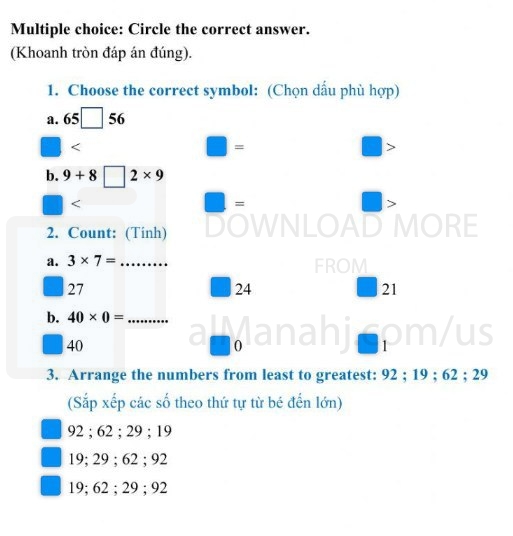File info: A Math Test for Term 1 is an assessment designed to evaluate students' understanding and proficiency in various math concepts and skills covered during the first term of a school year. The test typically includes a range of questions and problems that assess different areas of mathematics, such as number sense, operations, geometry, measurement, and data analysis. The purpose of the test is to assess students' knowledge, problem-solving abilities, and mathematical reasoning. Here's a description of what a Math Test for Term 1 might include:
1. Format: The test is usually presented in a written format, with questions and problems that students need to solve on paper. It may consist of multiple-choice questions, short-answer questions, or longer, more complex problems that require detailed explanations or calculations.
2. Scope of Content: The test covers the math concepts and skills taught during the first term of the school year. This may include topics such as place value, addition, subtraction, multiplication, division, fractions, geometry (shapes, angles, symmetry), measurement (length, weight, volume), time, money, data analysis (graphs, charts), and problem-solving strategies.
3. Knowledge and Understanding: The test assesses students' knowledge and understanding of key mathematical concepts. It includes questions that require students to demonstrate their comprehension of mathematical vocabulary, definitions, and principles. For example, students may be asked to define mathematical terms, identify geometric shapes, or explain the steps in a specific mathematical procedure.
4. Computational Skills: The test evaluates students' computational skills and proficiency in performing mathematical operations. It includes questions that require students to solve numerical calculations, such as addition, subtraction, multiplication, and division problems. These questions may vary in difficulty and complexity based on the grade level.
5. Problem-Solving: The test includes problem-solving questions that assess students' ability to apply mathematical concepts and strategies to real-life or mathematical scenarios. These problems may require students to analyze a situation, identify relevant information, and use mathematical operations or reasoning to find a solution. The questions may be presented as word problems or contextualized scenarios.
6. Reasoning and Mathematical Thinking: The test challenges students' reasoning skills and mathematical thinking. It may include questions that require students to make logical deductions, identify patterns or relationships, or analyze and interpret data presented in tables, graphs, or charts. These questions assess students' ability to think critically and apply mathematical concepts in different contexts.
7. Time Limit: The test is typically administered within a specific time frame to assess students' ability to work efficiently under time constraints. The duration of the test may vary depending on the grade level and complexity of the questions.
8. Grading and Evaluation: The test is scored based on predetermined criteria and standards. The grading may take into account factors such as correct mathematical procedures, accurate calculations, logical reasoning, and clear, organized responses. The test results provide feedback on students' individual strengths and areas for improvement in math.
It's important to note that the specific content, format, and difficulty level of the Math Test for Term 1 can vary depending on the educational institution, curriculum, and grade level. The purpose of the test is to assess students' progress and understanding of the math concepts covered during the first term, and to provide feedback to teachers, students, and parents regarding their mathematical skills and abilities. |
